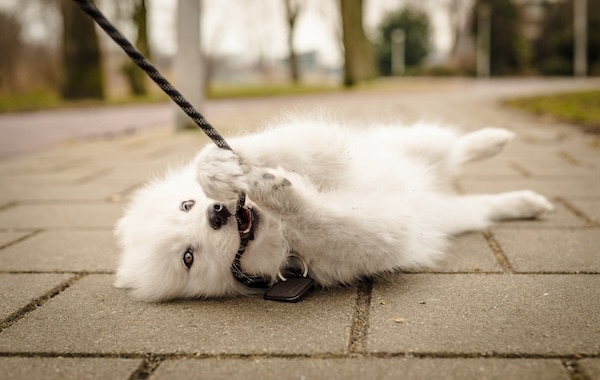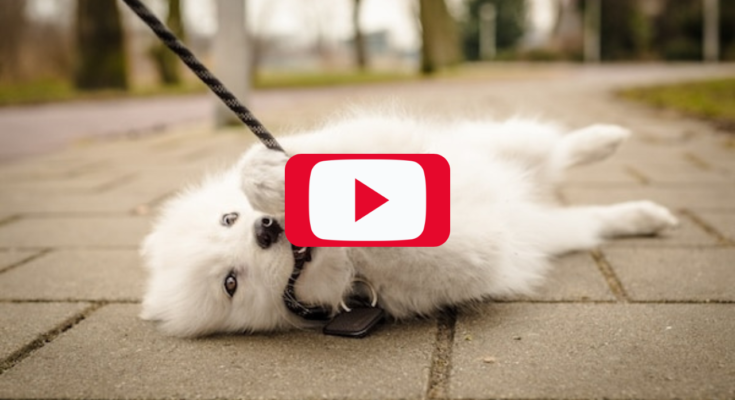“It’s normal for a puppy to stall, chase leaves, zigzag, and then be ready for a nap before you’ve hit the end of the block,” says. Malawey emphasizes the importance of aligning your goals with what your puppy is capable of right now—which may just be taking turns around the living room.
Leash walking doesn’t require a lot of equipment up front. Malawey recommends a 6-foot flat for safety. You’ll also want to stock up on tasty and choose a to ensure rewards are always at hand. When you’re ready for outdoor treks, it’s smart to get in the habit of bringing along a
First, work on walking without the leash
Before heading outside, it’s helpful to build some foundational skills without the leash.
“In these early lessons, you are teaching your puppy that it’s really fun to walk beside you, to see where you are going, and that staying close to you gets them rewards,” says . She lays out the following steps.
Choose a quiet, distraction-free place in your home and start without a collar, harness, or leash.
Make the area beside you a “magic spot” by giving your pup a treat when they are next to you.
Keeping the treat near the end of their nose, walk forward a few steps. Then, give them the treat.
Build this up slowly over several sessions until you can walk across the room and even do some turns.
If the puppy gets ahead of you, stop, lure them back with a treat, and carry on a few steps before rewarding them.
Menteith recommends practicing this in different rooms and even the backyard if it’s safe to do so.

Chalabala via iStock
Now it’s time to bring in the leash
Once your pup has some basic walking skills under their belt, it’s time to add the leash. We still want to go slowly and let our pups get acquainted with this new gear at their own pace. This teaches your puppy the leash is a good thing—not something they should fear or be apprehensive about.
, breaks it down for us.
Leave the leash on the floor and scatter treats around it. Let your puppy sniff and inspect the leash.
Sit on the floor with the leash behind your back.
Show your puppy the leash, reward them, then hide the leash. Repeat this several times.
Elevate the process by moving the leash towards your puppy, followed by a reward. (So the process becomes: show leash, move leash toward puppy, reward, remove leash, repeat.)
Add the step of clipping the leash to the puppy’s collar or harness. Reward while it’s attached. Then unclip, hide, and repeat.
At first, you can supervise your puppy while they drag the leash around around the house. Once they’re comfortable wearing the leash, you can return to your “walking beside me” exercises with the leash now in hand. Continue practicing indoors, as your puppy is less likely to get distracted in this controlled environment.
During your sessions, watch your puppy for signs they’re getting overwhelmed. If they’re pulling away or exhibiting signs of stress like excessive panting, drooling, or tucking their tail, you may need to take a step back. As always, patience is key. Don’t rush your puppy, and be patient with their progress. Remember, too, that puppies have short attention spans, and training sessions should be short and sweet for best results.
How To Start Walking with Your Dog
After practicing indoors for a while, it’s time to venture outside. Initially, you’ll want to start small. To minimize distractions, begin with short walks in a controlled area, such as your backyard or a parking lot. It’s also important to avoid areas frequented by lots of other dogs if your puppy isn’t fully yet.
“You might stay right outside your house or only go up and down your block,” says Malawey. “There is no need to take them on a mile trek right away.” As Malawey points out, the distance of these early walks is less important than allowing your pup to explore and enjoy this interactive bonding time.
Since super long walks can be physically and mentally tiring for a puppy, it’s best to limit your outings. “Let your puppy stop and sniff or just have a break frequently, and aim for no more than five minutes of leash walking for every month of their age,” Menteith recommends. That means a three-month-old pup will hit their max at 15 minutes.
To encourage polite walking, Menteith says to continue using positive reinforcement. “Use your voice and treats to keep [your dog] from pulling on the lead and walking beside you where possible.” It’s equally important to refrain from correcting your dog’s behavior by forcefully tugging on the leash. Remember, your puppy is excited! Instead, Menteith advises pet parents to stop walking, use their voice or even a food lure to bring their dog back to them, and then continue.
Don’t get discouraged if your puppy’s first walks are far from the long, leisurely strolls you’d envisioned. Puppies are bound to meander, take breaks, and sniff everything in sight. And that’s okay!
“All you should be aiming for in these early walks is that your puppy enjoys themselves,” says Menteith. “Be guided by your puppy. If you don’t get any more than a couple of meters from your gate, that’s fine. There’s plenty of time to build it up.”

Photography by Adri via iStock
Expert Tips for Resolving Common Leash Walking Issues
Training a puppy to be comfortable with a leash can be a daunting task. We ask the experts how to troubleshoot some common problems along the way.
What should I do if my puppy runs away from the leash?
This usually happens if a puppy’s first encounters with a leash are negative or they haven’t had a chance to get used to the leash. That’s why it’s important to start with deliberate desensitization. If your puppy is afraid of the leash, go back to gradually introducing it in a positive way. Don’t run after them or force the leash on them—instead, coax them gently with treats and praise.
You can also bring out the leash during positive moments like mealtime or playtime. With consistent positive reinforcement, most dogs will come around in a few weeks.
What should I do if my puppy gets too excited wearing the leash?
If your dog becomes a frenzied tornado every time the leash comes out, trainer Ali Smith suggests associating the leash with something less exciting. To do this, you can repeatedly take out the leash and then hang it back up. The goal here is to make grabbing the leash a boring, commonplace activity that doesn’t necessarily precede an exciting walk. With time, taking out the leash will no longer signal something super fun is about to happen.
What should I do if my puppy wanders all over the place and can’t walk in a straight line?
“Let them,” says Smith. “It’s their walk!” Remember that puppies are curious creatures with limited attention spans. It’s perfectly normal for them to zigzag across your path during their first walks. With patience, consistency, and positive reinforcement, they will eventually learn to walk in the desired
What if my puppy bites on their leash?
Smith recommends redirecting a chew-happy pup’s attention to a ball, stick, or


